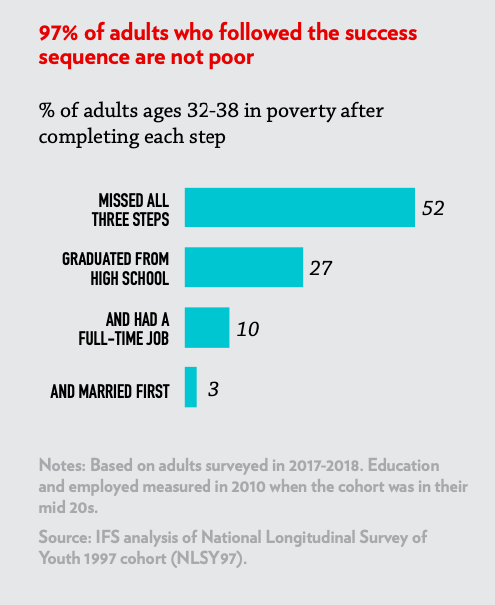
Executive Summary
The “Success Sequence,” a formula to help young adults succeed in America, has been discussed widely in recent years, including by Brookings Institution scholars Ron Haskins and Isabel Sawhill. The formula involves three steps: get at least a high school education, work full time, and marry before having children. Among Millennials who followed this sequence, 97% are not poor when they reach adulthood. The link remains strong when this cohort of young Americans reaches their mid-30s, according to a new IFS analysis of the National Longitudinal Survey of Youth (NLSY).1
The success sequence seems like common sense. In an interview, Nobel Laureate James Heckman called the success sequence a fact, adding: “When children or young adults have a child out of wedlock and if they take responsibility for that child—even if they don’t—that’s going to generally impair their progress.” Similarly, Bryan Caplan commented that the causation between the success sequence and poverty is obvious: “‘Dropping out, idleness, and single parenthood make you poor’ is on par with ‘burning money makes you poor.’ The demand for further proof of the obvious is a thinly-veiled veto of unpalatable truths.”

Critics of the success sequence often point out that it ignores the “obstacles individual efforts can’t always overcome.”There is no question that structural disadvantages make it more difficult to follow the three steps of the sequence. But that is also why it matters: Young adults who manage to follow the sequence— even in the face of disadvantages—are much more likely to forge a path to a better life.
In fact, young adults from disadvantaged circumstances who follow the sequence are markedly more likely to overcome challenges and achieve economic success. The vast majority of black (96%) and Hispanic (97%) Millennials who followed this sequence are not poor in their mid-30s (ages 32 to 38), as is also the case for 94% of Millennials who grew up in lower-income families and 95% of those who grew up in non-intact families. Moreover, for those who do not have a college degree but only finished high school and who work and marry before having children, 95% are not poor by their mid-30s.2
Not only does following the success sequence help young adults in adverse circumstances avoid poverty, but those who manage to stay on the sequence are forging a path to move up to the middle class and realize the American Dream. By their mid-30s, 80% of black young adults and 86% of Hispanics who have followed all three steps are in the middle- or higher-income bracket, compared with 91% of whites. The shares are similar among young adults who grew up in lower-income families (82%) and those who did not grow up with both parents (84%). Even though racial gaps in achieving middle class status still exist after following the success sequence, as Richard Reeves observed in cross-sectional data, the vast majority of black and Hispanic young adults are in the middle class or higher today after completing all three success sequence steps.
This report focuses on how structural factors (e.g., race/ethnicity, family income growing up) are linked to the success sequence for Millennials. We also looked at the role of high school graduation in the success sequence steps. Poverty is the main economic outcome used in this report. All analyses are based on data from NLSY97 Round 18 (conducted in 2017 and 2018) when these young adults were ages 32-38.3
1. The cohort interviewed in NLSY 97 was born between 1980 and 1984 and is considered the oldest group of Millennials. “Young adults” and “Millennials” are used interchangeably in this report.
2. In this analysis, finishing high school and having a full-time job (working 35+ hours per week and 50+weeks a year) were measured when respondents were in their mid-20s.
3. This is an update from the analysis in The Millennial Success Sequence report published in 2017. The two reports share a similar methodology.





